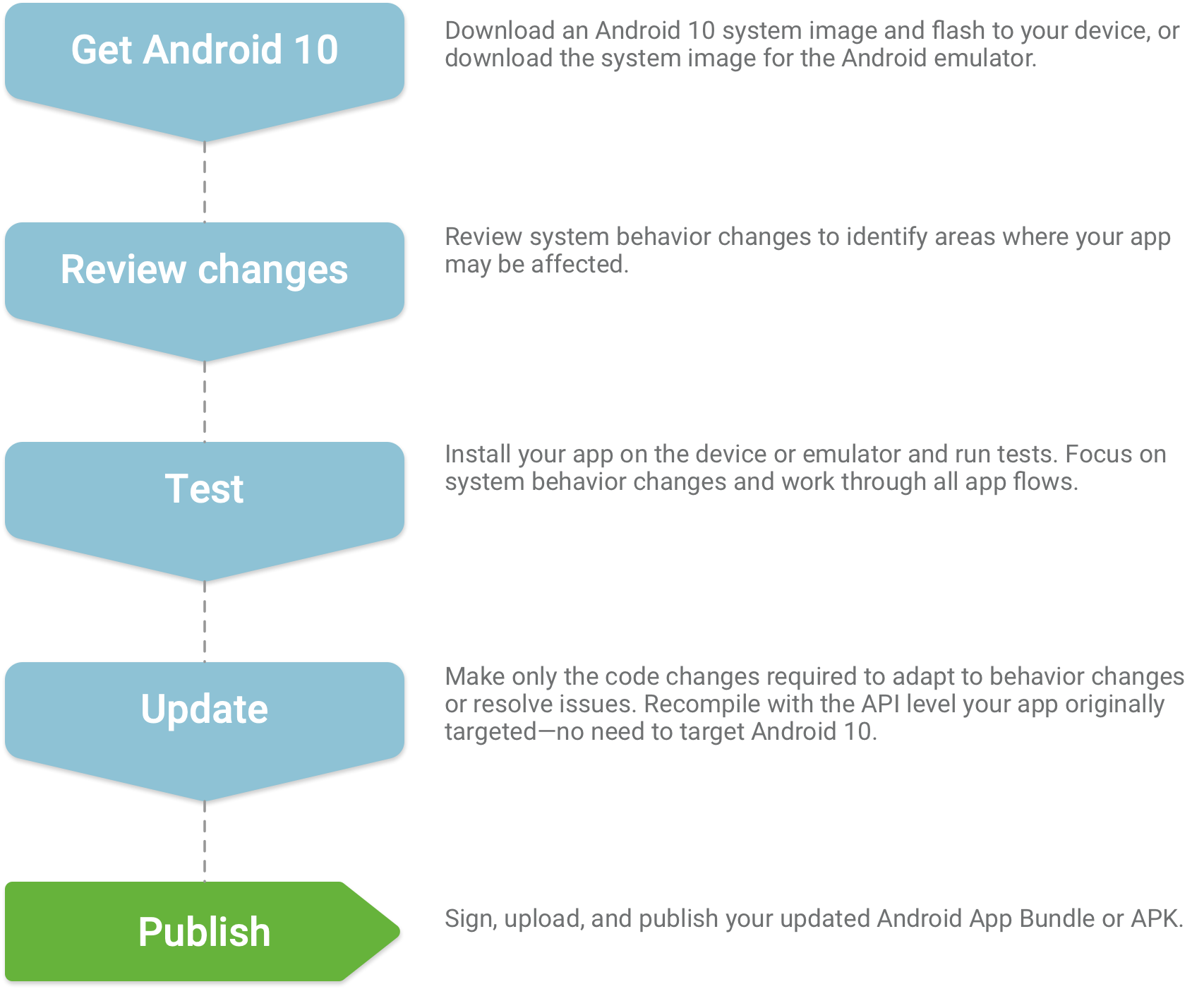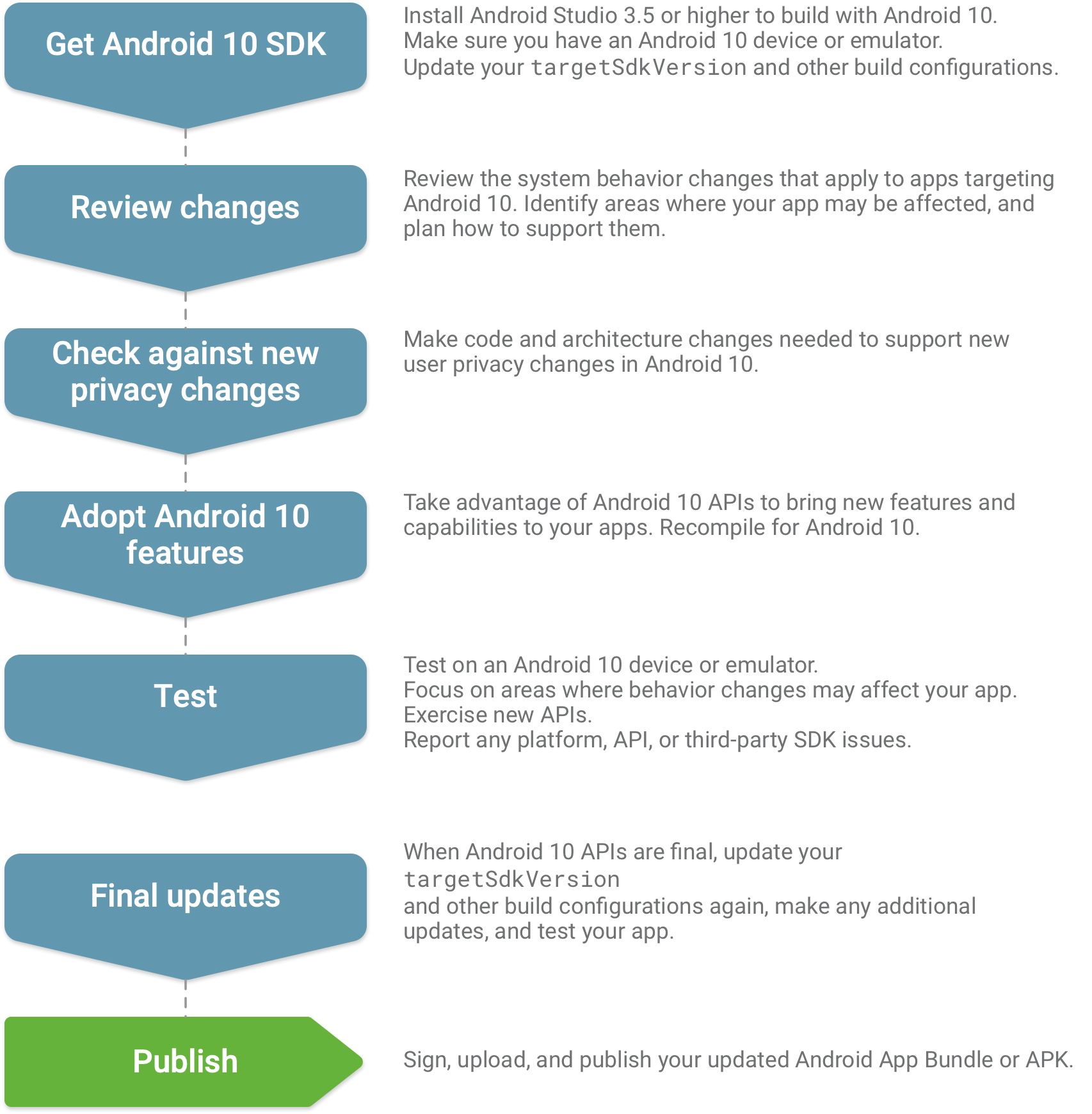ようこそ。Android 10 には新たなエクスペリエンスを構築するための新しい API が多数用意されているほか、システム動作も更新されているため、Android 10 デバイスで実行されるアプリに影響を及ぼす可能性があります。
最初にシステム動作の変更点、プライバシーの変更点、新しい機能と API について確認してから、次の 2 つのフェーズでアプリを移行することをおすすめします。
- 基本的な互換性を確認する。Android 10 に更新する、または Android 10 搭載の新しいデバイスを購入するユーザーに、既存の公開済みアプリの準備ができていることをできるだけ早く確認します。アプリをテストして問題なく機能することを確認し、互換性のあるバージョンのアプリをユーザーに公開します。
- Android 10 の機能と API を使ってビルドする。次に、Android 10 で新しい機能と API を試してみます。開発環境をセットアップし、アプリの
targetSdkVersionを変更してアプリに関連する新しい API でビルドします。
以降のセクションでは、各フェーズで必要なステップについて説明します。まず、アプリを実行してテストするためのハードウェア デバイスまたはエミュレータの準備ができていることを確認してください。
フェーズ 1: 基本的な互換性
このフェーズの目的は、アプリが Android 10 で実行されているときの機能低下やその他の影響を特定し、それに対処して、更新後のバージョンをユーザーに公開することにあります。多くの場合、アプリの targetSdkVersion を変更したり、新しい API を使用したりする必要はありませんが、必要に応じて compileSdkVersion を変更して互換性に対応することができます。
変更するプラットフォームによってはアプリの動作に影響を及ぼす可能性があるため、既存のアプリの機能はすべてのフローでテストしておくことが重要です。互換性のあるバージョンのアプリを公開するときは、更新メモで Android 10 サポートについてユーザーに通知することをおすすめします。
ユーザーが Android 10 にスムーズに移行できるように、互換性のあるバージョンのアプリをできるだけ早く公開することをおすすめします。デバイスが Android 10 アップデートを受信し始める前に公開するのが理想的です。

テストを実行する
互換性テストは、アプリのリリースに向けたテストと同じタイプのテストです。この機会に、アプリの中核品質ガイドラインとテストのおすすめの方法をもう一度確認することをおすすめします。
アプリに影響を及ぼす可能性のある既知の動作の変更について、よく理解してください。これらの動作変更は、targetSdkVersion を変更しなかった場合にもアプリに適用されます。事前に変更を確認しておくと、影響を受ける可能性のある領域を特定し、問題のデバッグが行いやすくなります。
Android 10 ではプライバシーに関する大幅な変更が行われています。プライバシーに関する重要な変更点を確認し、アプリに及ぶ可能性のある影響を理解してください。
フェーズ 2: Android 10 でビルドする
準備ができたらいつでも、Android 10 の新機能と API を使って、新しいエクスペリエンスでアプリを強化できます。新しい API で開発を始めるには、Android Studio で Android 10(API 29)SDK をセットアップし、targetSdkVersion と compileSdkVersion の両方を 29 に変更する必要があります。
targetSdkVersion を変更する場合は、Android 10(API 29)以降をターゲットとする際にアプリに適用されるシステム動作の変更も考慮する必要があります。
動作の変更によっては機能低下や障害が発生することがあるため、公開しようとしているアプリ アップデートによって targetSdkVersion が変更される場合は、公開前に必ずその変更を確認してテストしてください。

SDK を入手する
Android 10 でアプリを開発するための SDK パッケージを入手するには、まず Android Studio の最新版を使用していることを確認してください。詳しくは、SDK のセットアップをご覧ください。
テストを実行する
前述の準備が完了したら、アプリをビルドし、テストして、Android 10 をターゲットとしたときにアプリが正常に機能することを確認します。この機会にアプリの中核品質ガイドラインとおすすめのテスト方法も確認しておきましょう。
targetSdkVersion を 29 に設定してアプリをビルドする場合、特定のプラットフォームの変更点に注意する必要があります。Android 10 の動作変更ページに記載されているこれらの変更の中には、新しい API をまだ使用していない場合でも、アプリの動作に大きな影響を与えたり、障害を引き起こしたりする可能性があるものがあります。

